- Gold price posts modest gains around $2,465 in Wednesday’s early Asian session.
- The escalating tensions in the Middle East increase safe-haven demand, benefiting Gold.
- The US July Consumer Price Index report will be the highlight on Wednesday.
Gold price (XAU/USD) trades with mild gains near $2,465 during the early Asian session on Wednesday. The upside of the yellow metal might be underpinned by the safe-haven flows amid ongoing tensions in the Middle East. Traders will closely watch the release of the US July Consumer Price Index (CPI), which is due later on Wednesday.
Safe-haven demand from heightened tensions in the Middle East might lift the precious metal in the near term. The BBC reported on Tuesday that the United States sent a guided missile submarine to the Middle East as tensions rise in the region. The action comes in response to fears of a wider regional conflict after the recent assassination of senior Hezbollah and Hamas leaders. Analysts from Saxo Bank A/S noted that gold remains “supported by geopolitical risks and anticipated Federal Reserve rate cuts amid heightened tensions” involving Iran and Israel as well as Ukraine.
On Tuesday, Atlanta Fed President Raphael Bostic said that recent economic data made him “more confident” that the Fed can get inflation back to its 2% target. Still, more evidence is needed before he’s ready to support lowering interest rates.
The US CPI inflation report on Wednesday could offer some hints about the Federal Reserve’s (Fed) interest rate cut path. The CPI is expected to increase 0.2% MoM in July, compared to the previous month of a 0.1% decline. On an annual basis, the CPI inflation is estimated to ease to 2.9% in July from 3.0% in June.
The softer reading could fuel the chance of a Fed rate cut in September. On the other hand, a hotter inflation outcome might diminish the odds of a Fed easing policy, which is likely to exert some selling pressure on the non-yielding Gold.
Gold FAQs
Gold has played a key role in human’s history as it has been widely used as a store of value and medium of exchange. Currently, apart from its shine and usage for jewelry, the precious metal is widely seen as a safe-haven asset, meaning that it is considered a good investment during turbulent times. Gold is also widely seen as a hedge against inflation and against depreciating currencies as it doesn’t rely on any specific issuer or government.
Central banks are the biggest Gold holders. In their aim to support their currencies in turbulent times, central banks tend to diversify their reserves and buy Gold to improve the perceived strength of the economy and the currency. High Gold reserves can be a source of trust for a country’s solvency. Central banks added 1,136 tonnes of Gold worth around $70 billion to their reserves in 2022, according to data from the World Gold Council. This is the highest yearly purchase since records began. Central banks from emerging economies such as China, India and Turkey are quickly increasing their Gold reserves.
Gold has an inverse correlation with the US Dollar and US Treasuries, which are both major reserve and safe-haven assets. When the Dollar depreciates, Gold tends to rise, enabling investors and central banks to diversify their assets in turbulent times. Gold is also inversely correlated with risk assets. A rally in the stock market tends to weaken Gold price, while sell-offs in riskier markets tend to favor the precious metal.
The price can move due to a wide range of factors. Geopolitical instability or fears of a deep recession can quickly make Gold price escalate due to its safe-haven status. As a yield-less asset, Gold tends to rise with lower interest rates, while higher cost of money usually weighs down on the yellow metal. Still, most moves depend on how the US Dollar (USD) behaves as the asset is priced in dollars (XAU/USD). A strong Dollar tends to keep the price of Gold controlled, whereas a weaker Dollar is likely to push Gold prices up.







